Article by Joe Sapia
On Tuesday, I was talking to Kathy Clark, a biologist who has long been involved with the bald eagle restoration project for the state Department of Environmental Protection, and she surprised me with a question:
Do you know about the bald eagle nest at Route 33 and Applegarth Road?
Wow, no, I did not.
“It’s probably been there for two years,” said Clark, who works for the Endangered and Nongame Species Program in DEP’s Division of Fish and Wildlife.
But the state only found out about it in time to monitor the nest this year. And it fledged one chick! The nest is to appear in the state’s 2017 report, which will be out around the beginning of next year. Apparently, the nest will be listed as the “Upper Millstone” nest because of the Millstone River corridor in that area.
From 1970 to the early 1980s, New Jersey had only one confirmed nest — in the Delaware Bay area. In 2016, New Jersey had 172 nests. Of the 172, 150 had eggs, producing 216 fledglings.
The comeback of bald eagles, “Haliaeetus leucocephalus,” is attributable to the 1972 United States banning of DDT pesticide, which worked itself into the food chain and resulted in fragile eagle eggs. Also, in New Jersey, the DEP has done a considerable job with managing an eagles comeback.
Since the comeback era of eagles, Monroe has never had a confirmed nest. So, this is a rather big discovery – one proving there is a lot to save in Monroe environmentally and specifically in terms of open space. Otherwise, the nearest confirmed bald eagle nests to Monroe, based on the 2016 report, are in the areas of Cheesequake State Park/Old Bridge, East Brunswick/New Brunswick, Princeton, the Six Flags Great Adventure area, and Fort Dix. The state also believes there is a nest at the Assunpink Wildlife Management Area. Another nest is likely in the Old Bridge area, but the state lost track of that nesting pair in 2015.
Despite the comeback of the bald eagle, it remains in New Jersey an “endangered” breeder – that is, in immediate jeopardy as a breeder – and “threatened” in general – that is, in danger of becoming “endangered” if conditions deteriorate.
The Monroe nest will really be a test to see what the township and its residents are made of environmentally. I have not seen the nest, but know the property it is on. It is private property that looms for development. And the nest is incredibly close to existing development and we have seen how the Route 33-Applegarth Road intersection is developing.
As Clark noted, “It’s quite built-up.”
It is unknown why the eagles picked this spot, one that is not on a body of water, for example, for its preying on fish.
Clark said the eagles look for: “Is there a foraging area? Is there a tree that will support a nest in the long run?”
Or a utility tower, even.
The nests are huge, perhaps 4 or 5 feet in diameter, 2 to 4 feet deep – with the birds adding onto the nest each year. The largest documented eagle nest was 9-1/2 feet in diameter, 20 feet deep, weighing about 6,000 pounds, according to the National Eagle Center.
This nest is relatively close to Cranbury Lake, Hightstown Lake, Etra Lake, Perrineville Lake, and Jamesburg Lake, so there are bodies of water around.
Because eagle nests are so fragile – this one with the added development pressure around it – I am not giving out the exact location. One, there is no need to get close to the nest – think of it as the eagle’s bedroom, a private place. Two, knowing the nest is in the general area, people should have ample views of eagles flying over the area – and there are various wide-open views in the nest area. Plus, I suspect the sightings people are reporting – at Thompson Park, at the Monroe Library, around the Route 33-Applegarth Road area, one even on road-kill in downtown Jamesburg several days ago – are these birds. Three, there are severe federal penalties regarding human interaction with eagles. (It is illegal in general to even own an eagle feather.)
Mature eagles, about 30 inches in height, with a wingspan of almost 7 feet, are easy to spot – huge brown birds with white heads and white tail-feathers. But it takes eagles years to reach maturity, so they do not get the adult colors until they are 4- or 5-years-old.
What can we do?
One, if you know the location of the nest, do not publicize it.
Two, if you know the location of the nest, stay away from it – as in hundreds of feet away. Photo opportunities are better with flying eagles than nesting eagles.
Three, move road-kill off roadways. If the eagle decides to take advantage of road-kill, at least it will not get hit by a vehicle if the road-kill is off the roadway.
Four, think environmentally. Monroe’s new obsession with a magazine-photograph lawn around a McMansion on what was woods or farmland only a few years ago is ridiculous.
Five, put pressure on developers and government officials to go green.
Too bad the Township Council cut the open-space tax rate. It went from bringing in at estimated $1.8 million annually, down to an estimated $900,000. Had it stayed where it was, all that extra money would have come in, without a hike in taxes, for open space purchases.
As for the Monroe eagles, let them soar!
See https://www.allaboutbirds.org/guide/Bald_Eagle/id
See https://www.fws.gov/midwest/eagle/protect/index.html
Joe Sapia, 60, is a lifelong Monroe resident. He is a Pine Barrens naturalist and an organic vegetable-fruit gardener. Joe’s work also is at @JosephSapia on Twitter.com, along with Facebook.com on the Jersey Midlands page.
Drawing and article by Maya Fenyk (age 13)
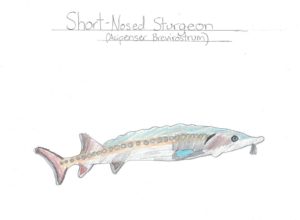
Short-Nosed Sturgeon
Hi! I’m Acipenser Brevirostrum, but you can call me Simon the Sturgeon. I am here to tell you about the many challenges I face as a two year old, juvenile short nosed sturgeon in the Raritan River. To start, I’d like to say how glad I am to be a sturgeon in 2017, even though my species has been federally endangered since 1973. Being a sturgeon living 120-150 years ago was even worse. Between the years 1870 and 1900, sturgeon were hunted for meat, but especially prized for their eggs for caviar.
We were nearly driven to extinction! Sturgeon are still feeling the effects 120 years later. Our population is only 12,000 in the waters New York and New Jersey, which truth be told is not a lot as female sturgeons lay 40,000 to 200,000 eggs per year. Caviar and hunting weren’t the only obstacle we have had to swim around to be able to survive. Another issue we face is river pollution. As bottom feeders we have a subterminal snout, we use our snout to vacuum our food from the substrate into our protractile mouth. This means that we pick up a lot of pollutants off of the substrate that isn’t food. We deserve to at least eat our meals of crustaceans, clams, mussels, snails, marine worms, flounder and plant matter, without having to guzzle down chemicals for dessert!
My species is considered a living fossil. We have been around for longer than 12,000 years and have retained a lot of primitive features that were common way back then, like our subterminal mouth and our barbels, a whisker like sensory organ. We have been in this area for longer than humans have, we have survived the caviar craze, and even industrial dumping that was common in Raritan for decades. That dumping residue along with the new stuff that has made its way to the Raritan (like expired medication, fertilizers and pesticides). These can turn into Endocrine System Disruptors (E.S.D) which damage our bodies and can either kill us or make us very sick. A lot of the pollutants also contain cadmium, arsenic are heavy metals that are extremely toxic.
Some ways you can help us live our natural life span of 35-70 years is by making sure to protect us from non-point source pollution. (That’s the pollution that is in stormwater runoff like pesticides, fertilizers, road salts and motor oil). You can make sure that streams have adequate buffers of plants and streams, and cleaning up our habitat will help. Also please let the NJDEP know if you see us. We are brown- gray fish with a yellow underbelly with a short rounded snout, heterocercal tail and a subterminal mouth, that is 18-22 inches long. Now I have to be going I see some yummy algae floating by. Though it isn’t fast food, but it sure moves pretty quick. Simon the sturgeon splashes out!
Dear Friends of the Lower Raritan Watershed –
It may be hard to believe, but many of the shorebirds that stop through the Lower Raritan Watershed have started their southern migration. Keep a look out for sanderlings, black-bellied plovers, red knots, least sandpipers and short-billed dowitchers. Knowing that our avian friends are already on their return trip home is a good reminder to get out in the field and enjoy the summer while it’s here!
We’ll celebrate the last last bit of summer at our next meeting, an after-work picnic on World Water Monitoring Day 2017. Join us in New Brunswick’s Boyd Park on Monday September 18 from 5:30-7:30pm, and bring your own picnic or something to share. We’ll supply beverages, paper products and dessert. Friends and family members welcome! (RSVPs requested). The evening will include water quality monitoring, project updates and a Raritan River “story slam” with coLAB Arts. Do you have a special Raritan River memory? Perhaps you swam in the Raritan as a kid, or have a story from a recent clean-up? Let us know! We are looking for 4-5 people to tell their stories on Sept 18. Storyteller confirms requested by August 31.
See you in the watershed,
Heather Fenyk, President
Lower Raritan Watershed Partnership
Article and photos by Joe Sapia
Note: The yard references are to my house in the section of Monroe between Helmetta and Jamesburg in South Middlesex County. My yard is in a Pine Barrens outlier on the Inner Coastal Plain, the soil is loamy, and my neighborhood is on the boundary of Gardening Zones 6b (cooler) and 7a (warmer). Afield references are to the Pine Barrens around Helmetta, unless otherwise noted. Notes and photographs are for the period covered, unless otherwise noted.
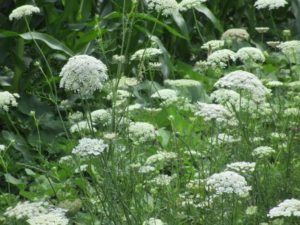
Queen Anne’s lace along a roadside in Monroe, Middlesex County.
THE DRIVE-BY NATURALIST: During the week, I noticed the white-flowered Queen Anne’s lace, “Daucus carota,” blooming along various roadsides. Also, blue-flowered chicory, “Cichorium intybus,” remains in bloom. This got me thinking, how we can observe nature as we drive by. As I try to point out, keep your eyes open – for plantlife and wildlife, along with looking up at the daytime and night skies. Nature is around us, so do not miss out on it. And keep the camera ready!
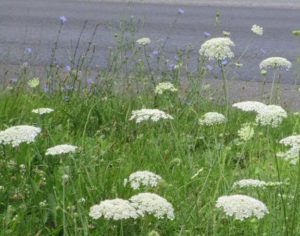
Here, Queen Anne’s lace, the white flower, and chicory, the blue flower, in bloom along a roadside.
ON MY DRIVE-BYS: Despite the warm temperatures during the week, I have been watching for the changing colors of foliage. Yes, it is only July, but the “fall” foliage changing of colors should be starting right about now in the wetlands in the Pine Barrens around Helmetta. I have not seen it yet, but I generally look for changing colors in swamps beginning somewhere in the July 15-to-July 31 period.
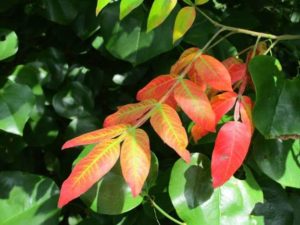
Here, leaves changing colors in 2015, late July, at Cranberry Bog in the Pine Barrens around Helmetta.
SPOTTED ON A DRIVE-BY: As I was putting together this week’s “Garden and Afield,” I shot some last-minute photographs and was driving home when I noticed some deer, “Odocoileus virginianus,” just off the road near Manalapan Brook on the Monroe-Spotswood boundary, Middlesex County. Usually when you see a fawn, Mama is nearby. On this day, though, I caught what I consider an uncommon sight, fawns and a buck (whose antlers were in velvet). Mama Deer was probably keeping an eye on the fawns from nearby in the woods.
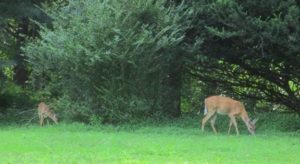
A fawn and a buck in Monroe, Middlesex County.
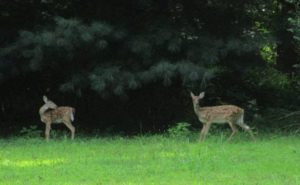
Two fawns in Monroe, Middlesex County.
LOW-MOISTURE-IN-THE-AIR BLUE SKY: Ever notice days when the sky just has that clear look to it? Based on my Roman Catholic upbringing and 16 years in Catholic schools, I call it a “Blessed Mother Blue Sky,” because the sky has the look of the blue clothing associated with the Virgin Mary. Joey Slezak, my go-to science guy in the Pine Barrens around Helmetta, calls it a “Bluebird Sky.” “The first I heard ‘Bluebird Skies’ is (when I was) skiing,” Joey said. “People talking about it. You have white (snowy) ground contrasting the blue sky.” Joey, who has a bachelor’s degree in meteorology from Rutgers University and has completed his master’s degree course work in meteorology at the university, explained the clearness translates as “low moisture” in the air.
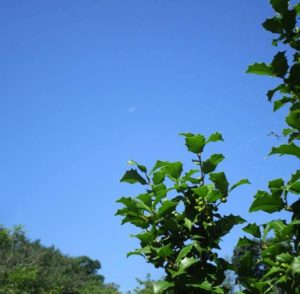
The clear blue sky is a result of low moisture in the air as the moon wanes after the July 8-9 overnight Full Thunder Moon. The next full moon is the August 7-8 overnight Full Red Moon
GARDEN ENEMIES: I have not seen the ground hog and its offspring lately, although the wood steps at one of my house doors is collapsing into their burrow. The rabbits are always around. Then, the other day, I found deer droppings and hoof prints in my garden. Finally, I found the tops of my tomato plants snipped off. Well, there goes this year’s tomato crop….
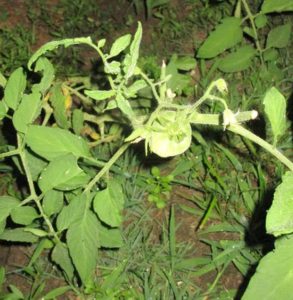
A snipped-off tomato plant in the garden.
WATERING THE GARDEN OBSESSION, NO. 1: On Sunday, July 16, for the first time since planting the food garden around May 20, I was able to water it completely by hand, using water I had accumulated in garbage can reservoirs. I used roughly 30 gallons for the 950-square-foot, or 315-row-feet garden. Now, to replenish the 20-gallon and 30-gallen barrels with rainwater, cellar de-humidifier water, water caputured while sprinkling the garden using the house system, and water from Manalapan Brook. (I keep the barrels covered so as not to promote mosquito development.)
WATERING THE GARDEN OBSESSION, NO. 2: With the water accumulated in my barrels, I thought I could cheat a little, by hooking up a simmer pump and hose to a sprinkler, rather than walking the garden with sprinkling cans. Well, I clogged the sprinkler, which required me unclogging it – but not until I gave up on using the pump for sprinkling. I guess the pump picked up gunk from the water barrel. And I am not even sure the pump was powerful enough to propel the sprinkler properly.
WATERING THE GARDEN, OBSESSION NO. 3 — MANALAPAN BROOK: I grabbed two buckets and took the walk of a few hundred feet to Manalapan Brook, the section between “Jamesburg Lake” (Lake Manalapan) and “Spotswood Lake” (DeVoe Lake). There, I was greeted by my friends, ebony jewelwing damselflies, “Calopteryx maculate.” I waded into the Brook, filled the two buckets, took some photographs, and headed home.
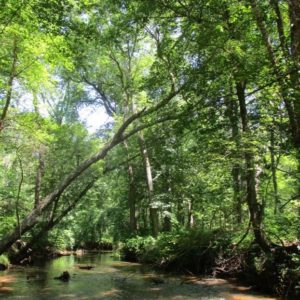
Manalapan Brook in the section of Monroe between Helmetta and Jamesburg, looking downstream toward Helmetta.
ELSEWHERE IN THE GARDEN: I am awaiting cantaloupe/mushmelon and sweet corn, both seemingly behind on the calendar from last year. The tomatillos, which I did not plant, are ready for harvesting; I will pass them along to a co-worker. Otherwise, I had some pea seeds laying around I decided to plant about a week or so ago; They are sprouting.
THE SIZE OF MY GARDEN: Friend, fellow hiker, and fellow gardener Priscilla “Peppy” Bath had an interesting observation about my garden: “Your vegetable garden is so good as you tell about it. I expected it to be much bigger. …Perhaps it would be interesting to others that you do not have one to two acres, but just a normal back yard.” Yes, my yard is only about a quarter-acre. “It would possibly encourage others to make a vegetable garden in their backyards,” Peppy said. I think people do not realize how productive a small garden could be. So, I reached out to friend Diane Larson, who is the home horticulturist and Master Gardener coordinator for the Rutgers University Extension Service office in Freehold, Monmouth County. The Monmouth County Master Gardeners garden is about 40 feet by 50 feet, or about 2,000 square feet. From 2006 to 2016, or over 11 growing seasons, the garden has produced 26,000 pounds of vegetables – an average of about 2,364 pounds per year, all donated to food pantries serving the needy. “The best part, besides all the produce going to food pantries, is that the MGs learn so much out there,” Diane said. “Some have never grown vegetables and they love it.”
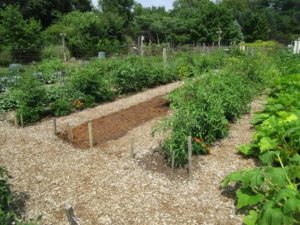
The Monmouth County Master Gardeners garden in Freehold Township. This 40-foot by 50-foot garden has averaged a yield of 2,364 pounds per year from 2006 to 2016, with all the food donated to the needy.

Another view of the Monmouth County Master Gardeners garden.
ZINNIA OBSESSION: My new obsessive-compulsive fascination – the zinnias I planted to attract pollinators to the food garden. For next year, I plan to dig up the front lawn and plant zinnias there, too.

Zinnias in the garden.
FIRE IN THE MAIN PINE BARRENS: A wildfire has burned about 3,500 acres in Wharton State Forest. The fire remained burning as of Saturday, July 22. The good news is the fire — whose cause is, so far, undetermined — is not near buildings, which means the fire, too, will help keep the Pine Barrens a pine barrens. The Pine Barrens is an early succession ecosystem, so the fire – by knocking down the oaks that would shade out the pines – keeps succession in check. The pines may look like burned spars, but they are alive and can regenerate from their trunks, along with root growth and new growth of wildfire-spread seeds; The oaks, on the other hand, cannot regenerate from the trunks, but have to start all over, so to speak, by root growth. On Saturday, the fire was considered “contained,” meaning firefighters had a safe perimeter around it.
ELSEWHERE IN THE YARD: I am slowly reclaiming my yard after 4-1/2 weeks of a major remodeling project on my house – new roof, soffits, gutters and drainpipes, and siding. (For the first time since the house was built in 1952, it is no longer mint green. The retro green has been replaced by barn red.) So, I have been cutting the lawn and trimming shrubs, along with figuring how to approach my neglected garden. And I finally put up the screen tent that has been sitting in a box in my garage for a few weeks. Now, without getting bit by mosquitoes, I can spend warm nights in the screen tent reading, writing, listening to the radio, or just enjoying being outside. Next year, I plan to put the screen tent in a better location, farther from the house, closer to the garden. So, I put up the screen tent and almost immediately it began raining, then monsooning. …Oh, yes, the contractors still have a few odds and ends to finish, but I do have the yard back under my control.
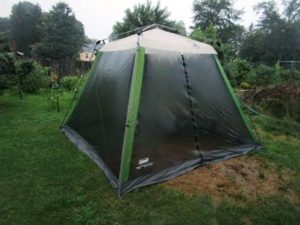
The brand-new, and rain-drenched, screen tent in my backyard.
SOURCES, BOOK NO. 1: One of my book sources is “Dictionary of Plant Names” by Allen J. Coombes, 1985 to 1989, Timber Press. I have had this book for an estimated 25 or more years and have repeatedly turned to it. It lists plants by common and scientific names, cross-referencing the two – for example, mountain laurel, “Kalmia latifolia.” It goes on, saying the genus name is from naturalist Pehr Kalm (who did work in the 1700s in the South Jersey area) and the species name translates from Latin as “broad-leaved.” Mountain laurel, according to the book, is also known as “calico bush.” I use this book both on its own and in conjunction with plant-illustration books.
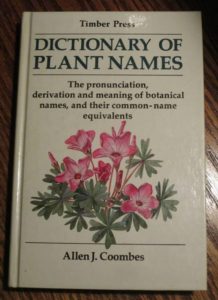
“Dictionary of Plant Names” by Allen J. Coombes
TURKEY FOLLOWUP: Bob Eriksen, a retired turkey biologist of the state Department of Environmental Protection, made some observations after seeing the photograph of the wild turkeys, “Meleagris gallopavo,” in the Pine Barrens around Helmetta published in the July 9 “Garden and Afield.” Bob said, “Good to see a hen turkey with at least three poults. They are all old enough that they likely will survive to adulthood.”
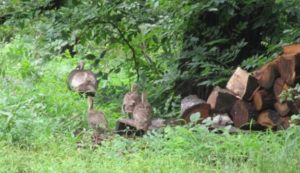
A turkey hen and her three poults in the Pine Barrens around Helmetta, specifically in the Jamesburg Park section of East Brunswick, Middlesex County.
ATLANTIC OCEAN TEMPERATURES: The ocean temperatures have run from about 70 degrees to the lower 80s. On July 18, Tuesday, Glenn “Hurricane” Schwartz, a Philadelphia television Channel 10 meteorologist, said online, “The Atlantic City ocean temperature is now up to 80 degrees. That’s practically unheard of for July. (It) peaks in August. 10 degrees above average.”
UPCOMING COUNTY FAIRS: Monmouth County Fair is July 26, Wednesday, to July 30, Sunday, in Freehold Township, https://www.monmouthcountyparks.com/page.aspx?ID=2492. Mercer County 4-H Fair, July 29, Saturday, and July 30, Sunday, in Hopewell Township, http://mercer.njaes.rutgers.edu/4h/fair/. Middlesex County Fair, August 7, Monday, to August 13, Sunday, in East Brunswick, http://middlesexcountyfair.com/. Somerset County 4-H Fair, August 9, Wednesday, to August 11, Friday, in Bridgewater, http://www.somersetcounty4h.org/fair/. Hunterdon County 4-H and Agricultural Fair, August 23, Wednesday, to August 27, Sunday.
SUNRISE/SUNSET: For July 23, Sunday, to July 29, Saturday, the sun will rise at about 5:50 a.m. and set about 8:18 p.m.
WEATHER: The National Weather Service forecasting station for the area is at http://www.weather.gov/phi/.
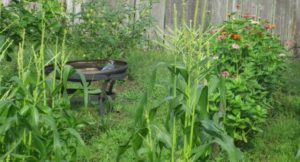
A blue jay rests in the garden, surrounded by sweet corn, tomatillos, and zinnia.
Joe Sapia, 60, is a lifelong Monroe resident. He is a Pine Barrens naturalist and an organic vegetable-fruit gardener.
He gardens the same backyard plot as did his Italian-American father, Joe Sr., and his Polish-immigrant, maternal grandmother, Annie Poznanski Onda. Both are inspirations for his food gardening. Joe is active with the Rutgers University Master Gardeners/Middlesex County program. He draws inspiration on the Pine Barrens around Helmetta from his mother, Sophie Onda Sapia, who lived her whole life in these Pines, and his Grandma Annie. Joe’s work also is at @JosephSapia on Twitter.com, along with Facebook.com on the Jersey Midlands page.
NJDEP – Notice of Rule Proposal
July 17, 2017
Coastal Zone Management Rules, N.J.A.C. 7:7
Freshwater Wetlands Protection Act Rules, N.J.A.C. 7:7A
Flood Hazard Area Control Act Rules, N.J.A.C. 7:13
Proposed amendments, repeals, and new rules
PUBLIC NOTICE
Take notice that the NJ Department of Environmental Protection (Department) is proposing amendments, repeals, and new rules to the Coastal Zone Management Rules in response to issues identified through stakeholder outreach and to address other issues that have arisen since the July 6, 2015 adoption of the consolidated coastal rules. The proposed amendments are related to shellfish aquaculture, filled water’s edge, dune walkovers and other beach and dune development, CAFRA findings, V zones, scenic resources and high-rise structures, permits to apply herbicide, trails, building access in flood hazard areas, application requirements, and rule rationales. Amendments and new rules are additionally proposed in the Freshwater Wetlands Protection Act Rules and Flood Hazard Area Control Act Rules as part of the Department’s continuing effort to align the three land use permitting programs to the extent possible.
The proposal is scheduled to be published in the New Jersey Register dated July 17, 2017. A copy of the proposal is available at http://www.nj.gov/dep/rules/proposals/20170717a.pdf and from LexisNexis free public access to the New Jersey Register, www.lexisnexis.com/njoal.
Public hearings concerning the proposal are scheduled as follows:
Thursday, August 10, 2017, at 6:00 P.M.
City of Long Branch Municipal Building
Council Chambers, 2nd Floor
344 Broadway
Long Branch, NJ 07740
Tuesday, August 15, 2017, at 10:00 A.M.
Campus Center Theater
Stockton University
101 Vera King Farris Drive
Galloway, NJ 08205
Written comments may be submitted electronically by September 15, 2017 at http://www.nj.gov/dep/rules/comments; or in hard copy to:
Gary J. Brower, Esq.
ATTN: DEP Docket No. 11-17-06
NJ Department of Environmental Protection
Office of Legal Affairs
Mail Code 401-04L; PO Box 402
401 East State Street, 7th Floor
Trenton, NJ 08625-0402
One of the first things most 3rd or 4th graders learn in earth science is that water runs downhill. By 6th or 7th grade kids can make the connection between pollution of waters uphill and contamination larger waterways in lower lying areas as the polluted water flows downhill.
The Lower Raritan Watershed Partnership thinks that rationale ought to be enough to include small river tributaries, headwaters and wetlands under the federal Clean Water Act to ensure protections for the waters of the United States (WOTUS). Despite the important role these waters play in keeping our environment, and our drinking water, clean and healthy the EPA is seeking to rollbacks protections.
In June the EPA issued its proposal to repeal the “waters of the United States regulation,” also known as the Clean Water Rule, that clarifies protections for headwaters, seasonal streams and wetlands. The Clean Water Rule clarifies protections for the headwaters, seasonal streams and wetlands that feed drinking water supplies for more than 117 million Americans, and protects the wetlands that provide critical flood storage and wildlife habitat. If the Clean Water Rule is repealed, federal protections will be reversed on 60 percent of U.S. streams and 20 million acres of wetlands. What is the goal of this policy reversal? To make it easier for these already-vulnerable lands to be used for extractive projects: open-pit mining, gas fracking, tar sands oil and other pipelines, all uses with tremendous impacts on our local ecologies, especially our local water systems.
If you think that our New Jersey streams and wetlands are protected because earlier generations in the Garden State had the foresight to create the nation’s strongest freshwater wetlands protection measures (the 1987 New Jersey Freshwater Wetlands Protection Act), think again. Since 1990 our Lower Raritan Watershed has lost 3,461 acres of forested wetlands, 2,891 acres of emergent wetlands, 1,086 acres of agricultural wetlands, and 593 acres of disturbed wetlands (Sustainable Raritan River Initiative, 2016). Negative effects of wetlands loss in the LRW include an intensification of flooding of our communities, and pollution loading in our Raritan River and area streams. And earlier this year the NJ Department of Environmental Protection submitted FWPA rules revisions proposals that significantly cut protections from these valuable lands (6.25.2017 – public comment on FWPA). Furthermore, a reduction in protections in neighboring New York and Pennsylvania – states without strong protection measures – will mean that pollution in those states will roll downhill right into New Jersey’s waters.
A NJSpotlight analysis indicates that this rollback could threaten more than half of New Jersey’s streams and wetlands, and could compromise drinking water for up to 6 million people. By repealing these federal and state rules we put polluter profits ahead of the needs of our communities, businesses, and environment. Repealing these rules is an assault on basic protections for clean water that puts millions at risk.
But here’s the thing — the EPA won’t get rid of the Clean Water Rule without public input. We need to flood the EPA with our comments. We need members of Congress and businesses speaking out. We need citizens demanding their elected officials fight for our right to clean water.
Here is a sample of some of the messages that ordinary people who want the existing rules on clean water strengthened have shared with the EPA. Please consider sharing your message, the comment period is open until August 28:
I am extremely fond of breathing clean air and drinking clean water, I would like these things to be available to my children and grandchildren. Please keep the regulations in place that help protect our air and water. Short term profits for corporations do not outweigh the long term benefit of a healthy environment.
As one of a majority of Americans I do not support any weakening of regulations that insure that we have clean water, clean air and healthy soil. I support the clean power regulations to reduce air pollution from coal plants. Those regulations will save many lives … Do not weaken the ability of the EPA to protect our clean water, soil and air.
Please work to keep our water, air, and land clean and safe for all people. Regulations that protect the water we drink, the air we breathe, the land where our food is grown, where our children play, the open spaces that people and animals need and enjoy should not be removed. This means that existing regulations on mining, industry, farming and other activities that require safe practices and healthy outcomes are also essential. Keep America clean and healthy for all.
The current administration has made it clear that their intent is to jeopardize the health of the planet in order to enrich the pockets of the fossil fuel industry … The blatant disregard for the quality of our country’s air and water is disheartening and will not be forgotten in upcoming election cycles.
Article and photos by Joe Sapia
Note: The yard references are to my house in the section of Monroe between Helmetta and Jamesburg in South Middlesex County. My yard is in a Pine Barrens outlier on the Inner Coastal Plain, the soil is loamy, and my neighborhood is on the boundary of Gardening Zones 6b (cooler) and 7a (warmer). Afield references are to the Pine Barrens around Helmetta, unless otherwise noted. Notes and photographs are for the period covered, unless otherwise noted.
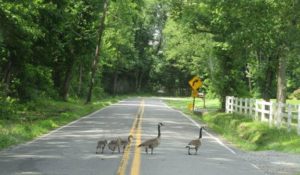
Mama and Papa Canada geese, “Branta canadensis,” and their young cross a road in the Dayton section of South Brunswick, Middlesex County, and stop my Jeep in its tracks. Silly geese! (On a serious note, humans could learn from the dedicated parenting of Canada geese.)
GOOD TO BE BACK HOME: Sorry for missing last week’s “Garden and Afield,” but I was down in New Orleans or traveling to and from. I was attending receptions for a medical residency graduation (of Dr. Anthony M. Sciascia II, the son of my college buddy) and wedding (of Anthony and Nancy). I had a wonderful time with the Sciascia clan who has treated me as family since our Marquette University days that began more than 40 years ago. But I always enjoy getting back home….
SOME N’AWLINS FLAVOR IN THE JERSEY MIDLANDS: New Orleans is known for its coffee made from the roots of chicory, “Cichorium intybus.” Well, guess what has began blooming in the Jersey Midlands? Chicory, the blue flower along roadsides and other disturbed areas. It is a foreign species naturalized here. That is, a weed. But a weed with a nice-looking flower.
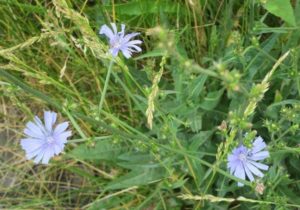
Chicory growing on a Monroe roadside.
IN THE GARDEN: While I was gone, my garden did not get its daily watering, even more critical because we had some very hot temperatures, near 100! But I began harvesting lettuce in earnest.
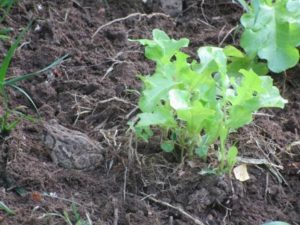
Lake Valley Seeds’s “Salad Bowl Green Heirloom Lettuce” grows in my garden. Next to the lettuce is nature’s pesticide, a toad — probably an American toad, “Anaxyrus americanus.” (Thanks to Sam Skinner, a Monmouth County Park System naturalist who set me in the right direction on the tentative identification of this toad.)
MY ORGANIC GARDEN: I just mentioned the wild toad as a natural pesticide. But, nowadays, people seem to be touchy over the term “organic,” arguing its meaning or arguing that “organic” does not mean purely natural. As I was taught in journalism, say exactly what you mean, rather than using labels. So, here is how I food garden – I add nothing to the mix except water.
MANALAPAN BROOK: The Brook flows about 400 feet from my front yard, but, thankfully, I am about 150 feet from its floodplain – so, close enough to enjoy the waterway, but far enough away not to be affected by flooding. This time of year, the Brook has a summer feel, with lush vegetation growing in the floodplain and, on this day, bright sunlight creeping through the trees. My section of the Brook is between “Jamesburg Lake” (Lake Manalapan) and “Spotswood Lake” (DeVoe Lake). Its watershed drains 40.7 square miles, according to the United States Geological Survey, in Middlesex and Monmouth Counties.
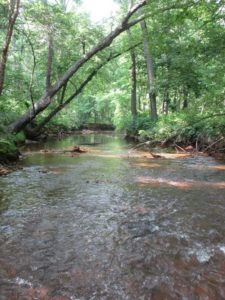
Manalapan Brook, looking downstream toward Helmetta
LIGHTNING BUGS: I saw the first lightning bug, a member of the “Lampyridae” insect family, of the season June 4. On June 17, as I was putting together this “Garden and Afield,” I watched fireflies in my backyard. There seemed to be more than normal, maybe a half-dozen to a dozen, but not the numbers I remember when I was a kid. They flash to signal mates.
ELSEWHERE IN THE YARD: Also in the yard over the last two weeks were rabbit, genus “Lepus”; the state bird, the Eastern goldfinch, “Spinus tristis,”; and my friend, the catbird, “Dumetella carolinensis.” The rabbits allow me to get within a few feet of them, probably because I go about my normal business, not TRYING to get close. The male goldfinch is brightly colored, a beautiful bird – “wild canaries” in the yard. I love catbirds. When I work in the yard or hike the Pine Barrens around Helmetta, catbirds perch nearby and keep me company.
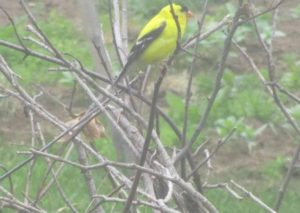
An Eastern goldfinch. Brightly colored, so it is a male.
WHITE ORCHID: Faye Bray, a friend from the Outdoor Club of South Jersey, reported a rare white variety of the pink lady-slipper orchid, “Cypripedium acaule,” in the Whitesbog, Burlington County, area of the Pine Barrens. “It’s freaking remarkable,” Faye said. (Unfortunately, we could not get a photograph for “Garden and Afield.”)
TURTLES: Turtles have been laying eggs, meaning females have been moving around. On my trip to and from New Orleans, I saw a half-dozen or so dead along the Interstate highways, apparently struck by vehicles. Up here in the Midlands, I have heard of various encounters with turtles. One, a person moved a box turtle, “Terrapene carolina,” to water. Wait, a box turtle is a land animal. Two, another person moved a snapping turtle, “Chelydra serpentina,” to a pond, possibly interrupting its egg-laying. So, my advice is, unless there is a compelling reason, leave wildlife alone. Generally, it knows what it is doing, it does not need humans to mess up its life.
TICKS: Ticks are bad this year. Essentially, they cling to vegetation and wait for a mammal to brush by them, then they attach. We have three ticks locally: deer tick, “Ixodes scapularis”; lone star tick, “Amblyomma americanum,” The female is easily distnguishable by the light-colored dot on her back; wood tick, also known as the dog tick, “Dermacentor variabilis.”
Get a tick ID pocket card. It will show the size and colors of not only these ticks, but in different stages of development. See http://www.tickencounter.org/tick_identification/guide.
There is no need to panic. Tick-borne diseases are relatively rare — I mean, if everyone in range of a tick, or even bitten by a tick, were to get sick, there would be a very sick population. However, be vigilant. In the yard, keep grass trimmed. If in the woods, take precautions by dressing properly. (If I am wearing long pants, for example, I tuck them in my socks.) And check for ticks on one’s body. When coming in from the woods or other places ticks are likely, wash the clothes and bathe as soon as possible.
If a tick is crawling on oneself, simply flick it off — It may take a few tries. If one is attached, take tweezers and grab it behind the head and pull it out. Then flush it down the toilet, throw it in a fire, or, if needed for observation, put it with an alcohol-doused cotton swab in a closed container.
If bitten, observe the bite for abnormalities, such as the Lyme Disease bull’s eye, seek medical help if concerned. The big tick disease locally is Lyme. However, New Jersey is now watching for Powassan virus.
My yard is wildlife-friendly and I take no special precautions in the yard, other than observing my clothes and body. I am always in the woods and fields, I found one tick on my body this season, but 10x or 20x that on my clothes — the point being, notice them before they get on one’s body.
Regarding the yard, keep the grass cut. I have tall-grass wildlife patches in my yard and have not found a tick on me yet while doing yardwork, etc. I would be more concerned with cats and dogs bringing them inside.
If you look them up online, use the scientific name, so as not to confuse species and colloquial names.
LETHAL ANIMALS: I would say on a daily basis, the three most lethal animals in the Pine Barens around Helmetta are the tick, mosquito, and pet dog. The former two could do a number for life, while the latter one could be hurtful for the moment.
In the Piedmont region of the Jersey Midlands, I would add copperhead snake, “Agkistrodon contortrix.” In the main Pine Barrens, the rattlesnake, “Croatus horridus.” But the chances of getting bit by either is rare.
Throughout the Midlands, a wandering black bear, “Ursus americanus,” could be a threat – but unlikely. If you see one, stay clear and that should be enough.
YOU SAY “MUSKMELON,” I SAY “MUSHMELON”: My friend Virginia Lamb, who I have turned to for advice (environmental, gardening, and general) over the years, said in reference to my using “mushmelon,” “It’s ‘muskmelon, not ‘mushmelon.’” She is correct, in a more formal sense. But I am correct, too, in a more informal way. So, I responded in an e-mail, “Local colloquialism = mushmelon. I use that only in my blog. Normally, when I talk, I say cantaloupe. (Kind of like the colloquialism “garden snake” for “garter snake.)” Yes, we are all talking cantaloupe.
SCIENTIFIC NAMES: My use of scientific names also has prompted some discussion. Sunil Nair, who has followed my Internet nature posts, said, “Love the fact that you write the genus names, too.” But Virginia Lamb noted, “Just a note on reader preference: I feel the Latin names interrupt the folksy flow of the prose and would prefer they be noted at the end. But that may just be me.” I am considering Virginia’s point. As for using scientific names, I do it so there is no question what is being discussed. “Swamp pink” could be the “Arethusa bulbosa” orchid or it could be the “Helonias bullata” lily. But a scientific name is a scientific name is a scientific name.
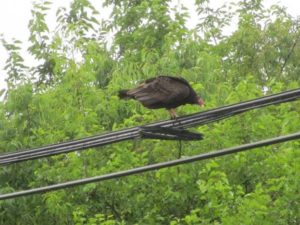
A turkey vulture, “Cathartes aura,” sits on a roadside utility line in Monroe after I spooked it when it was eating a dead ground hog, “Marmota monax.” Here, it is easily identified by its red head. Turkey vultures are commonly seen, soaring in a circle, their wings tipped into a V.
SUNRISE/SUNSET: For June 18, Sunday, to June 24, Saturday, the sun will rise between 5:25 and 5:30 a.m. and set about 8:30 p.m.
DATE TO KEEP IN MIND, JUNE 21: The longest daylight of the year is Wednesday, June 21, the summer solstice, when the sun rises at 5:28 a.m. and sets at 8:31 p.m. After June 21, daylight gets shorter.
DATE TO KEEP IN MIND, JUNE 24: St. John the Baptist Day. Sophie Majka, a neighbor who died March 8 at 92-years-old, had told me blueberries are ready to pick in the Pine Barrens around Helmetta on St. John’s Day, June 24. So, that is a target I look to.
WEATHER: The National Weather Service forecasting station for the area is at http://www.weather.gov/phi/.
SOURCES: As you can see, I have already mentioned various sources of information. Additionally, I enjoy listening to Mike McGrath’s “You Bet Your Garden” radio show on WHYY, 90.9 FM, out of Philadelphia – or on the Internet at http://whyy.org/cms/youbetyourgarden/. I also read Sally McCabe’s “In the Garden, It’s Time To…” column in the Philadelphia Inquirer newspaper, or on the Internet at philly.com.
MORE N’AWLINS FLAVOR IN HELMETTA: Why do I love traveling in the South? Maybe because I am a boy of the South – South Middlesex County. And my local roots go back to Helmetta, whose founder, for lack of a better term, George Washington Helme, was a Confederate military officer. Although a native of Kingston, Pennsylvania, Helme was a New Orleans resident during the Civil War. After the war, he came up to Helmetta, where his wife’s, Margaret Appleby Helme’s, family had a snuff mill operation – one that George would eventually take over. The George W. Helme Snuff Mill provided my family with work for approximately 75 years, from circa 1900 to 1976. The mill stopped manufacturing snuff in 1993 and, now, it is being converted into housing.
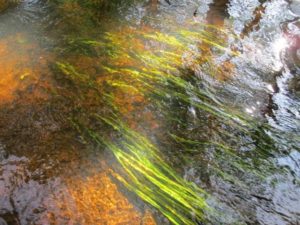
Looking into sunlit Manalapan Brook, here between Helmetta and Jamesburg.
Joe Sapia, 60, is a lifelong Monroe resident. He is a Pine Barrens naturalist and an organic vegetable-fruit gardener.
He gardens the same backyard plot as did his Italian-American father, Joe Sr., and his Polish-immigrant, maternal grandmother, Annie Poznanski Onda. Both are inspirations for his food gardening. Joe is active with the Rutgers University Master Gardeners/Middlesex County program. He draws inspiration on the Pine Barrens around Helmetta from his mother, Sophie Onda Sapia, who lived her whole life in these Pines, and his Grandma Annie. Joe’s work also is at @JosephSapia on Twitter.com, along with Facebook.com on the Jersey Midlands page.
Article and photos by Joe Sapia
Note: The yard references are to my house in the section of Monroe between Helmetta and Jamesburg in South Middlesex County. My yard is in a Pine Barrens outlier on the Inner Coastal Plain, the soil is loamy, and my neighborhood is on the boundary of Gardening Zones 6b (cooler) and 7a (warmer). Afield references are to the Pine Barrens around Helmetta, unless otherwise noted. Notes and photographs are for the period covered, unless otherwise noted.
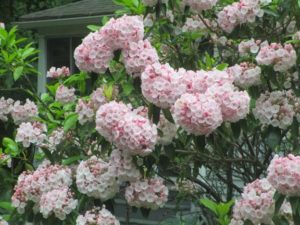
Mountain laurel, “Kalmia latifolia,” in bloom in the Pine Barrens around Helmetta, specifically the Jamesburg Park section of East Brunswick, Middlesex County.
MORE MOUNTAIN LAUREL LORE: I have mentioned here before the Pine Barrens lore I had heard, “The snapping turtle lays its eggs when mountain laurel blooms.” Here is some woods lore I just heard, “The deer would give birth around the time mountain laurel blooms.”
If you find a fawn, “Odocoileus virginianus,” seemingly by itself, leave it. Its mother is probably nearby, waiting for you to leave. If you come across a snapper, “Chelydra serpentine,” that needs to be moved from, say, a road, move it to safety in the direction it is traveling. It probably is a female, heading to uplands to lay eggs or returning to water after laying eggs. BE CAREFUL WITH SNAPPERS. More Piney lore, “Only the setting sun or lightning makes a snapping turtle let go.” I move them with a shovel, preferably a big grain shovel. Joey lore, “If a snapping turtle bites and will not let go, shove a wire in its nostril. Or maybe a flashing light will make it let go.”
Wild mountain laurel is virtually impossible to transplant.
Mountain laurel’s scientific name is “Kalmia latifolia.” The genus name comes from Pehr Kalm, a European botanist who worked in the South Jersey area in the 1700s. He published the influential “Travels into North America.” The plant’s species name is Latin for “broad-leaved.”
A SHORE GARDEN: On a newspaper reporting freelance story, I was at the home of artist Laura Petrovich-Cheney and her husband, educator and craftsman Peter Cheney, in Asbury Park, Monmouth County. Their property is on Deal Lake. There, a great egret, “Ardea alba”, and red-winged blackbird, “Agelaius phoeniceus,” flew along the lake. Purple martins, “Progne subis,” nest in houses on the property. In the gardens were various flowers in bloom: roses, poppies, daylilies (budding), peonies, yarrow, and trumpet vine honeysuckle. Also in gardens were Tears of Mary, tomato, eggplant, cucumbers, herbs, raspberry bushes, and a fig tree.
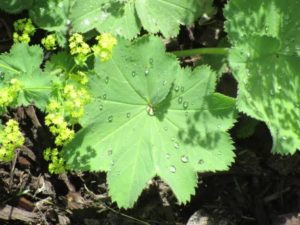
“Tears of Mary” plant in the Petrovich-Cheney and Cheney garden in Asbury Park, Monmouth County.
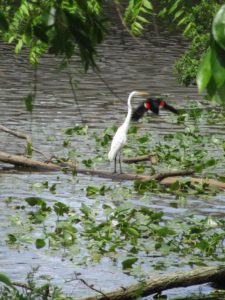
A red-winged blackbird flies past a great egret on Deal Lake at the Cheney and Petrovich-Cheney garden.
BIRD BATHS IN THE YARD: When my birdbath broke a few years ago, I took the bath part and laid it on the ground. When that had seen its days, I started using a garbage can lid, laying it on the ground. Now, I use large saucers – two in the backyard along the fruit and vegetable garden and one in the front yard. They are used by various animals: bird; squirrel; “Sciurus carolinensis”; and neighborhood cat, maybe even by skunk, “Mephitis mephitis”; chipmunk, “Tamias striatus”; raccoon, “Procyon lotor”; and ground hog, “Marmota monax.”
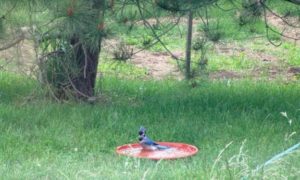
A blue jay, “Cyanocitta cristata,” in one of my backyard bird baths.
WATERING THE GARDEN: I water the garden before 10 a.m. so as not to lose water to evaporation in the heat of the day and so the garden dries by nightfall, preventing fungal growth. I use two watering methods – one, by sprinkling can if I have enough clean water accumulated (from rain, the cellar de-humidifier, and so on) and, two, by running a sprinkler. Sitting there with a cup of coffee and watching the sprinkler go back and forth is so relaxing. This week, a mourning dove, “Zenaida macroura,” joined me.
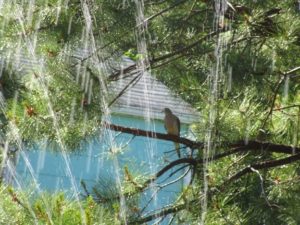
A mourning dove perches in a pitch pine – “Pinus rigida,” transplanted to my backyard from a Pine Barrens woods in Monmouth County – and hangs out with me as I watched the sprinkler water the garden.
BUTTERFLIES: As I have mentioned before, I am noticing a lot of tiger swallowtails, “Papilio glaucus,” the females black and the males yellow, this year. I usually cannot shoot a good photograph because they do not sit still. This week around my garden, I had a very cooperative female, allowing me to photograph away.
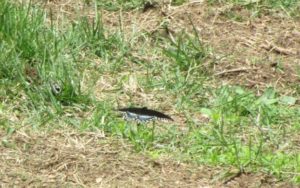
A female tiger swallowtail cruises over my garden.
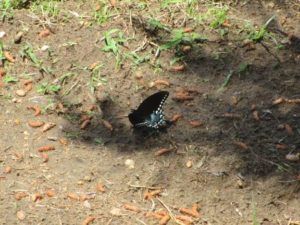
She rests in the garden.
DELAWARE RIVER AT FIELDSBORO: I was along the Delaware River near Fieldsboro, Burlington County. This is where the river transforms from commercial shipping (here and south) to recreational (here and north). Although the water here is fresh, there is a tidal effect as far north on the river as the area of Trenton, Mercer County.

Dawn on the Delaware River, looking toward the area of Fieldsboro, Burlington County.
CLOUDS: Over the last several months, clouds have been spectacular. On the evening of May 31, Wednesday, I was along the Delaware River in the Fieldsboro area. It was clear where I was, but to the north were storm clouds with occasional streaks of lightning. The lightning was too sporadic for me to catch a photograph, but I shot pictures of the storm clouds and sunset. (Tip on photographing lightning: If the lightning is flashing near enough to one another, do not try to catch the flash. Instead, just keep on cranking pictures and hopefully there will be a usable shot of lighting in the batch – and hopefully you were not struck by lightning!)

Man in the cloud blows fire at a jet along the Delaware River.
LIGHTNING: A few years back, a Jersey Shore beachgoer at the Atlantic Ocean in clear weather was struck and killed by “out of the blue lightning” because, despite the clear weather at the beach, a thunderstorm was near enough. So, play it safe. The rule I follow, “If you hear thunder, you can be struck by lightning.” Seek cover.
NIGHT SKY: At dawn, look for the bright “star” in the East – the planet Venus. The Full Rose Moon is Friday, June 9. On Saturday, June 3, I stood on my back porch and looked at the moon, with the planet Jupiter just off it. I find it fascinating I can stand in my yard and look at the wonders of the night sky in the home I grew up in – and followed the USA-Soviet Union “Space Race” in the 1960s. Turn off the outside lights, let your eyes adjust for 20 minutes to 30 minutes, and enjoy a naked-eye view of the Night Sky.

The planet Jupiter aligned with the moon on the night of Saturday, June 3.
UNDER THE PORCH: After working an overnight shift, I came home to find a pile of dirt under one of my back porches, the one at the Florida room. Enough dirt in the pile to fill a wheelbarrow. I suspect a ground hog. I raked up the dirt and moved it to my garden, where I likely will rake it out in the fall. As for the animal hole, I let it be. Wildlife is welcome in my yard, but I prefer it does not mess with my vegetable-fruit garden.

The work of a ground hog, I presume.
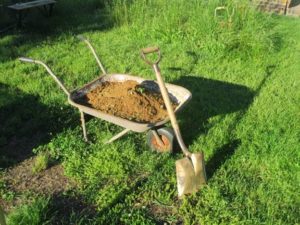
Off to the garden with the dirt. I can always find a use for it.
SUNRISE/SUNSET: For June 4, Sunday, to June 17, Saturday, the sun will rise about 5:30 a.m. and set about 8:25 p.m.
WEATHER: The National Weather Service forecasting station for the area is at http://www.weather.gov/phi/.
MY GARDEN: I continue with the three Ws – water, weed, and wait. The cool weather plants of lettuce and carrot are growing nicely, but the pea are lame. As for the warm weather plants, cucumber, mushmelon, and sweet corn, along with zinnia, are poking through the ground. No sign yet of tomato. (And I am thinking I may abandon planting tomato from seed. I am considering for next year buying plants and transplanting them into the garden.)
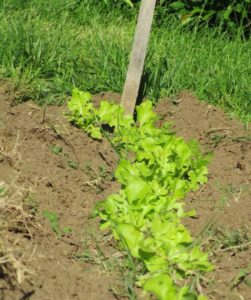
Salad Bowl Lettuce,” by Lake Valley Seed, growing in my garden.
UPCOMING “GARDEN AND AFIELDS”: After I publish a “Notes from Garden and Afield,” I panic, thinking, Will I be able to fill next week’s issue? Then, I realize there is plenty happening afield and in the garden. Alas, because of a scheduling conflict I have, “Notes from Garden and Afield” will not publish June 11. The plan is for it to return June 18. Meanwhile, check out on your own what is happening afield and in the garden.
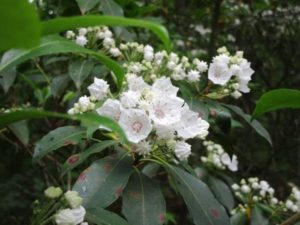
Mountain laurel, in bloom and about to bloom fully, in Jamesburg Park.
Joe Sapia, 60, is a lifelong Monroe resident. He is a Pine Barrens naturalist and an organic vegetable-fruit gardener.
He gardens the same backyard plot as did his Italian-American father, Joe Sr., and his Polish-immigrant, maternal grandmother, Annie Poznanski Onda. Both are inspirations for his food gardening. Joe is active with the Rutgers University Master Gardeners/Middlesex County program. He draws inspiration on the Pine Barrens around Helmetta from his mother, Sophie Onda Sapia, who lived her whole life in these Pines, and his Grandma Annie. Joe’s work also is at @JosephSapia on Twitter.com, along with Facebook.com on the Jersey Midlands page.
The following include May 2017 highlights of local/state news-worthy environmental concerns, as well as national headlines to watch:
New Jersey Water Supply Plan Update: After a 20 year wait, the New Jersey Department of Environmental Protection released a 2017-2022 Water Supply Master Plan Update. Specific to the Lower Raritan Watershed and our “Central Drought Region” are proposed Capital Improvement Projects including a North/South Branch Confluence pumping station, the Kingston Quarry Reservoir, water transfers from central to coastal North Drought Regions and the Six Mile Run Reservoir (pages 74-77).
New Jersey Freshwater Wetland Protection Act (FWPA) Rules Amendments: The NJDEP is proposing comprehensive amendments to NJ’s FWPA. These amendments propose significant revisions particularly to mitigation rules, and also to transition area (freshwater wetland buffer) impacts. Of note is that the proposed revisions increase the degree to which transition areas can be impacted by development. Written comments will be accepted until June 30th.
Rollbacks on Obama-era climate rules: Last week the Federal Highway Administration announced that it will delay the effective date of Green House Gas emissions analysis and air quality studies on US Interstate roadways.
Rollbacks on Pesticides: The Hill reports that House passed legislation last week to loosen federal regulations on pesticides. The “Reducing Regulatory Burdens Act of 2017” would reverse a 2009 court decision that requires that anyone applying pesticides secure a general permit under the Clean Water Act, opening the door to increased pesticide impacts on our waters.
Trump to pull out of Paris Climate Accord: Reuters reports that the United states will no longer be part of the landmark Paris Climate Agreement designed to reduce impacts of global warming.
Article and photos by Joe Sapia
Note: The yard references are to my house in the section of Monroe between Helmetta and Jamesburg in South Middlesex County. My yard is in a Pine Barrens outlier on the Inner Coastal Plain, the soil is loamy, and my neighborhood is on the boundary of Gardening Zones 6b (cooler) and 7a (warmer). Afield references are to the Pine Barrens around Helmetta, unless otherwise noted. Notes and photographs are for the period covered, unless otherwise noted.
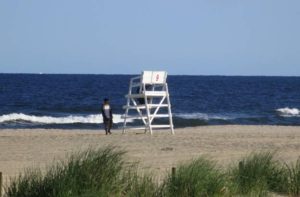
The Atlantic Ocean beach at Bradley Beach, Monmouth County
THE JERSEY SHORE SUMMER SEASON: The traditional Jersey Shore summer season arrives with Memorial Day Weekend, this weekend, and ends with Labor Day, this year September 4. (A tip: Jersey Shore people know September is a great month at the Shore – the crowds are gone and the weather and ocean are still warm.)
SPRINGTIME AT TONY’S MARKET: A favorite Jersey Midlands place of mine for decades has been Tony’s Farm and Garden Center in the Windsor section of Robbinsville, Mercer County. A nice selection of various products and owned and operated by the warm and helpful Ciaccio family. I regularly patronize three nursery-garden centers: Ferris Farms in East Brunswick, Krygier’s Nursery in South Brunswick, and Tony’s. At Tony’s, I buy houseplants and houseplant supplies. And I try to always shoot photographs at Tony’s.

Flowers at Tony’s Farm and Garden Center in the Windsor section of Robbinsville, Mercer County.
SIX-MILE RUN RESERVOIR SITE: On Wednesday, May 24, I hiked this area in Franklin, Somerset County, with the Outdoor Club of South Jersey. The area, about 3,000 acres and part of the Delaware and Raritan Canal State Park, had been planned for a reservoir, but that did not come to be. The terrain of red shale soil and traprock is part of the Piedmont geologic region. While pretty terrain – an area that I want to re-visit soon – much of it appears to be grown-over farmland, rather than a pure ecosystem.
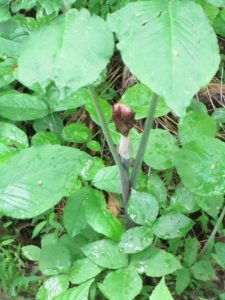
A Jack in the Pulpit flower, “Arisaema triphyllum,” in past-peak bloom at Six-Mile Run Reservoir.
MUSHROOMS: The wet weather may have produced mushrooms popping up in your yard or you simply may see mushrooms in the woods. BE CAREFUL! In my 60 years, I have learned only two mushrooms I feel comfortable picking – and I probably would still eat them with hesitancy out of fear, warranted or not. Remember the adage, “There are old mushroom pickers. There are bold mushroom pickers. There are NO bold AND old mushroom pickers.” It may be best to stay away from mushrooms in garden or afield.
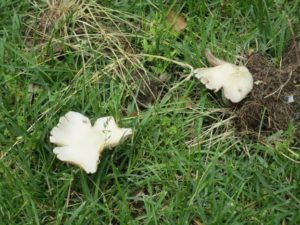
Mushrooms popping up post-rain in my backyard.
TURTLES AND MOUNTAIN LAUREL: Some Pine Barrens lore, “When the mountain laurel blooms, the snapping turtle lays its eggs.” Mountain laurel, “Kalmia latifolia,” is coming into bloom and, yes, snapping turtles, “Chelydra serpentina,” and other turtles are moving about. On Saturday, May 27, Priscilla “Peppy” Bath reported seeing a snapping turtle near her Mercer County home: “There was a huge turtle in the road. We stopped. Another car stopped and the turtle was not injured. But it was a big snapping turtle and the man was afraid to pick it up. Then, a young man on a bicycle came along and he picked it up and got it out of the road.” On the same day, I was driving on Route 206 in Burlington County and had to swerve to miss a box turtle, “Terrapene carolina carolina,” crossing 206. The car behind my Jeep hit it, but it appeared to nick it safely, knocking it to the side of the road. So, a heads-up while driving. If you move a turtle, move it in the direction it was traveling. If it is a snapper, I would use a shovel, not my hands. And, if using one’s hands, do not pick it up by its tail, which could injure it.
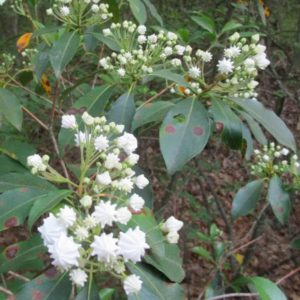
Mountain laurel about ready to go into full bloom at Jamesburg Park in the Pine Barrens around Helmetta.
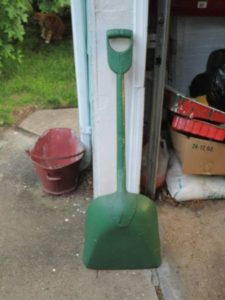
I keep this type of grain shovel in my Jeep to move snapping turtles off roads.
TREE MULCHING: I see so many examples of “volcano” mulching, or the wrong way to mulch a tree. Creating the volcano-look, or the pileup of mulch against a tree could cause too much wetness around the bark or make the tree susceptible to insect infestation or disease. Instead, use the “doughnut” method of placing the “doughnut hole” outside of the tree and its exposed roots, so the mulch is not touching bark. Outside of the hole, the mulch should be about only 2 or 3 inches in depth, so as not to overwet the tree. The outer rim of the “doughnut” should go to the end of the root ball or the tree canopy/drip line. If a tree is established, there is no need for mulching.
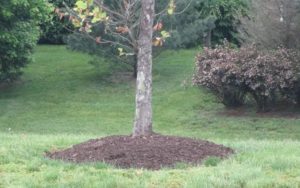
The mulch “volcano,” or the wrong way to mulch a tree, in South Brunswick, Middlesex County.
BLACKWELLS MILLS GARDENS: The gardens looked beautiful, here — in Franklin, Somerset County — which is part of Delaware and Raritan Canal State Park.
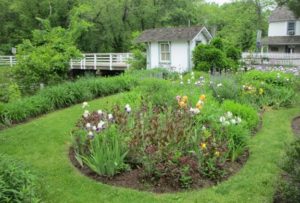
The garden at the circa 1830 bridge tender station at Blackwells Mills.
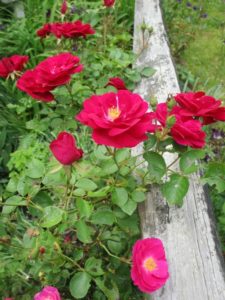
Flowers at Blackwells Mills.
MOON: The crescent moon waxes toward the June 9 Full Strawberry Moon.
GARDEN AND AFIELD: I already had some lower broom sedge, “Andropogon virginicus variety abbreviates,” gathered, here, in the Pine Barrens around Helmetta on display on my kitchen table. So, with my “Knock Out” Roses blooming, I just added some of those to the vase.
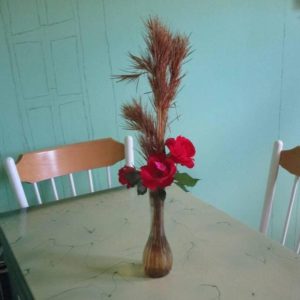
“Knock Out” Roses and lower broom sedge on my kitchen table.
SUNRISE/SUNSET: For the week of May 28, Sunday, to June 3, Saturday, the sun will rise about 5:30 a.m. and set about 8:20 p.m.
WEATHER: The National Weather Service forecasting station for the area is at http://www.weather.gov/phi/.
MY GARDEN: I am simply practicing the three Ws: Water, Weed, and Wait – waiting for lettuce, carrot, pea, sweet corn, tomato, mushmelon, cucumber, and zinnia to grow and be picked.
Joe Sapia, 60, is a lifelong Monroe resident. He is a Pine Barrens naturalist and an organic vegetable-fruit gardener.
He gardens the same backyard plot as did his Italian-American father, Joe Sr., and his Polish-immigrant, maternal grandmother, Annie Poznanski Onda. Both are inspirations for his food gardening. Joe is active with the Rutgers University Master Gardeners/Middlesex County program. He draws inspiration on the Pine Barrens around Helmetta from his mother, Sophie Onda Sapia, who lived her whole life in these Pines, and his Grandma Annie. Joe’s work also is at @JosephSapia on Twitter.com, along with Facebook.com on the Jersey Midlands page.















































